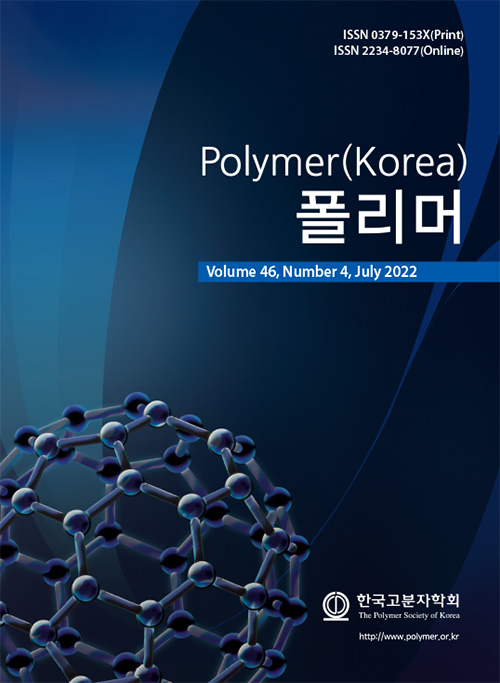- Study on Polymer Blends from Recycled Polypropylene and Plastic Waste Processed in a Hydrothermal Carbonization Process
Advanced Materials Science and Engineering, College of Engineering, Kongju National University,
Cheonan, Chungnam 31080, Korea
*R&D Center of Green Environment Corporation, 7, Beolmal 2-ro, Dongnam-gu, Cheonan, Chungnam 31068, Korea- 수열 탄화 공정을 거친 폐플라스틱 잔여물/재활용 폴리프로필렌 고분자 블렌드에 관한 연구
공주대학교 신소재공학부, *㈜그린환경 연구소
Reproduction, stored in a retrieval system, or transmitted in any form of any part of this publication is permitted only by written permission from the Polymer Society of Korea.
References
- 1. Tsuji, T.; Hasegawa, K.; Masuda, T. Thermal Cracking of Oils from Waste Plastics. J. Mater. Cycles Waste Manag. 2003, 5, 102-106.
-

- 2. Yan, G.; Jing, X.; Wen, H.; Xiang, S. Thermal Cracking of Virgin and Waste Plastics of PP and LDPE in a Semibatch Reactor Under Atmospheric Pressure. Energy Fuels 2015, 29, 2289-2298.
-

- 3. Corma, A.; Sauvanaud, L.; Mathieu, Y.; Al-Bogami, S.; Bourane, A.; Al-Ghrami, M. Direct Crude Oil Cracking for Producing Chemicals: Thermal Cracking Modeling. Fuel 2018, 211, 726-736.
-

- 4. Rudzinski, W. E.; Aminabhavi, T. M. A Review on Extraction and Identification of Crude Oil and Related Products Using Supercritical Fluid Ttechnology. Energy Fuels 2000, 14, 464-475.
-

- 5. Carr, A. G.; Mammucari, R.; Foster, N. R. A Review of Subcritical Water as a Solvent and Its Utilization for the Processing of Hydrophobic Organic Compounds. Chem. Eng. J. 2011, 172, 1-17.
-

- 6. Goto, M. Chemical Recycling of Plastics Using Sub- and Supercritical Fluids. J. Supercrit. Fluids 2009, 47, 500-507.
-

- 7. Zhao, X.; Xia, Y.; Zhan, L.; Xie, B.; Gao, B.; Wang, J. Hydrothermal Treatment of e‑waste Plastics for Tertiary Recycling: Product Slate and Decomposition Mechanisms. ACS Sustain. Chem. Eng. 2019, 7, 1464-1473.
-

- 8. Triyono, B.; Prawisudha, P.; Aziz, M.; Pasek, D.; Yoshikawa, K. Utilization of Mixed Organic-plastic Municipal Solid Waste as Renewable Solid Fuel Employing Wet Torrefaction. Waste Manag. 2019, 95, 1-9.
-

- 9. Areeprasert, C.; Ma, D.; Prayoga, P.; Yoshikawa, K. A Review on Pilot-scale Applications of Hydrothermal Treatment for Upgrading Waste Materials. Int. J. Environ. Sci. 2016, 7, 425-430.
-

- 10. Martinez, C. L. M.; Sermyagina, E.; Saari, J.; de Jesus, M. S.; Cardoso, M.; de Almeida, G. M.; Vakkilainen, E. Hydrothermal Carbonization of Lignocellulosic Agro-forest Based Biomass Residues. Biomass Bioenergy 2021, 147, 106004
-

- 11. Lu, L.; Namioka, T.; Yoshikawa, K. Effects of Hydrothermal Treatment on Characteristics and Combustion Behaviors of Municipal Solid Wastes. Appl. Energy 2011, 88, 3659-3664.
-

- 12. Prawisudha, P.; Mu’min, G. F.; Yoshikawa, K.; Pasek, A. D. In The Effect of Stirring in the Hydrothermal Process to Convert the Mixed Municipal Solid Waste into Uniform Solid Fuel, Proceedings of the 3rd AUN/SEED-NET Reginal Conference on Energy Engineeing and the 7th International Conference on Thermofluids, Yogyakarta, Indonesia, Nov. 19-20, 2015; Kamal, S., Saptoadi, H., Sentanuhady, J. Eds.; AIP Publishing: Melville, NY, 2016; Vol. 1737.
-

- 13. Shen, Y. A Review on Hydrothermal Carbonization of Biomass and Plastic Wastes to Energy Products. Biomass Bioenergy 2020, 134, 105479.
-

- 14. Zhao, X.; Zhan, L.; Xie, B.; Gao, B. Products Derived from Waste Plastics (PC, HIPS, ABS, PP and PA6) via Hydrothermal Treatment: Characterization and Potential Applications. Chemosphere 2018, 207, 742-752.
-

- 15. Iñiguez, M. E.; Conesa, J. A.; Fullana, A. Hydrothermal Carbonization (HTC) of Marine Plastic Debris. Fuel 2019, 257, 116033.
-

- 16. Son, Y. Development of a Novel Microcompounder for Polymer Blends and Nanocomposite. J. Appl. Polym. Sci. 2009, 112, 609-619.
-

- 17. Shen, Y.; Yu, S.; Ge, S.; Chen, X.; Ge, X.; Chen, M. Hydrothermal Carbonization of Medical Wastes and Lignocellulosic Biomass for Solid Fuel Production from Lab-scale to Pilot-scale. Energy 2017, 118, 312-323.
-

- 18. Düdder, H.; Wütscher, A.; Stoll, R.; Muhler, M. Synthesis and Characterization of Lignite-like Fuels Obtained by Hydrothermal Carbonization of Cellulose. Fuel 2016, 171, 54-58.
-

- 19. Khan, T. A.; Kim, H.; Gupta, A.; Jamari, S. S.; Jose, R. Synthesis and Characterization of Carbon Microspheres from Rubber Wood by Hydrothermal Carbonization. J. Chem. Technol. Biotechnol. 2019, 94, 1374-1383.
-

- 20. Adolfsson, K. H.; Lin, C.; Hakkarainen, M. Microwave Assisted Hydrothermal Carbonization and Solid State Postmodification of Carbonized Polypropylene. ACS Sustainable Chem. Eng. 2018, 6, 11105-11114.
-

- 21. Fang, C.; Nie, L.; Liu, S.; Yu, R.; An, N.; Li, S. Characterization of Polypropylene-polyethylene Blends Made of Waste Materials with Compatibilizer and Nano-filler. Composites Part B 2013, 55, 498-505.
-

- Polymer(Korea) 폴리머
- Frequency : Bimonthly(odd)
ISSN 0379-153X(Print)
ISSN 2234-8077(Online)
Abbr. Polym. Korea - 2022 Impact Factor : 0.4
- Indexed in SCIE
 This Article
This Article
-
2022; 46(4): 497-505
Published online Jul 25, 2022
- 10.7317/pk.2022.46.4.497
- Received on Mar 31, 2022
- Revised on May 15, 2022
- Accepted on May 17, 2022
 Correspondence to
Correspondence to
- Younggon Son
-
Advanced Materials Science and Engineering, College of Engineering, Kongju National University,
Cheonan, Chungnam 31080, Korea - E-mail: sonyg@kongju.ac.kr










 Copyright(c) The Polymer Society of Korea. All right reserved.
Copyright(c) The Polymer Society of Korea. All right reserved.